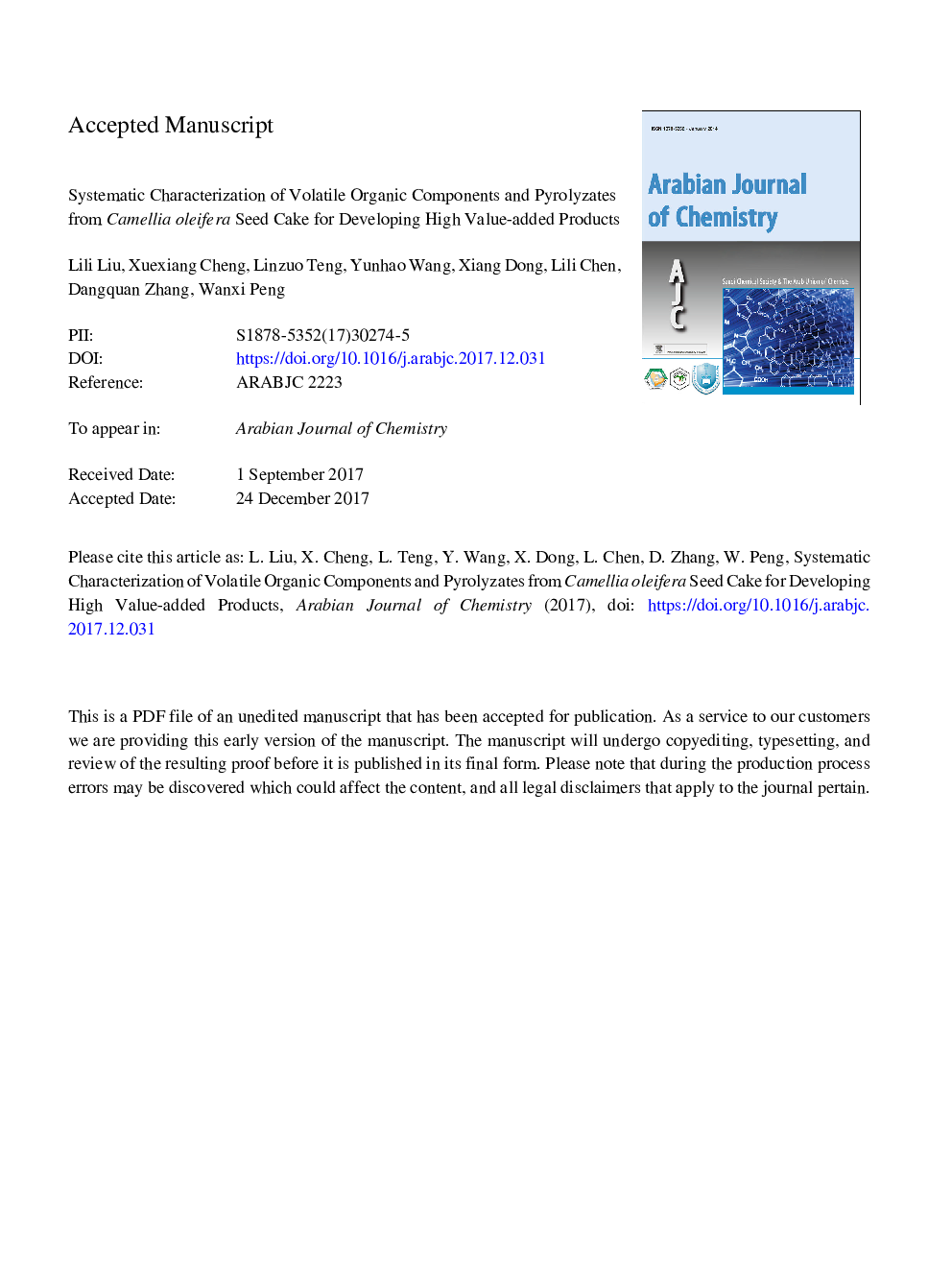| کد مقاله | کد نشریه | سال انتشار | مقاله انگلیسی | نسخه تمام متن |
|---|---|---|---|---|
| 10154582 | 1666306 | 2018 | 21 صفحه PDF | دانلود رایگان |
عنوان انگلیسی مقاله ISI
Systematic characterization of volatile organic components and pyrolyzates from Camellia oleifera seed cake for developing high value-added products
ترجمه فارسی عنوان
توصیف سیستماتیک از اجزای آلی فرار و پیرولیزات از کیک دانه کاملیا اولیفر برای تولید محصولات با ارزش افزوده
دانلود مقاله + سفارش ترجمه
دانلود مقاله ISI انگلیسی
رایگان برای ایرانیان
موضوعات مرتبط
مهندسی و علوم پایه
شیمی
شیمی (عمومی)
چکیده انگلیسی
Camellia oleifera seed cake (COSC), a byproduct during oil production of C. oleifera seeds, has been extremely abundant. However, due to the lack of systematic and in-depth analysis about the chemical composition of COSC, it is difficult to develop high value-added products, resulting in low processing efficiency or even directly abandoned. In this paper, the VOCs (Volatile organic components) characteristics of COSC and the variation rule of COSC groups before/after extraction were revealed, and the thermal loss law of COSC and the pyrolyzates characteristics at different temperatures were also explained. The main VOCs of ethanol extractive of COSC are alcohols, those of petroleum ether extractive are alkanes and organic acids, and those of benzene/ethanol extractive are esters. It is first reported here that rich 1,6,10-Dodecatrien-3-ol,3,7,11-trimethyl-, (E)-, namely nerolidol with wide use in cosmetics and biomedicine, exists in COSC extractives. In addition, bioactive VOCs such as β-caryophyllene, humulene and (E)-Atlantone were observed in three COSC extractives. The total content trend from high to low is petroleum ether extractive, ethanol extractive, benzene/ethanol extractive, indicating that petroleum ether extractive has the best developing prospects. The analytic results of FTIR further confirm that: (1) the COSC contains components including Si compounds, ethers, organic acids, esters and alcohols, (2) the four kinds of organic silicon detected are naturally occurring components in COSC, and (3) organic solvent extraction does not make compound groups of COSC significantly changed. There are four obvious stages in thermogravimetry treatment of COSC: the first (30-100â¯Â°C), the second (180-240â¯Â°C), the third (240-400â¯Â°C), and the fourth (400-567â¯Â°C), and the order of the mass loss is the third, the second, the fourth and the first. During thermogravimetry treatment, three critical turning points of temperature (240â¯Â°C, 400â¯Â°C and 567â¯Â°C) were observed, accompanied by significantly chemical changes such as macromolecule pyrolyzed into small volatile molecules. The four COSC extractive pyrolyzates at 300â¯Â°C, 450â¯Â°C, 600â¯Â°C and 750â¯Â°C have different content variation in the components, such as heterocyclic type with a high-low-high-low change, hydrocarbons and acids shown by the high-low-low-high process, and ketone and the alcohol with a low-high-low-high change. The 450â¯Â°C pyrolyzates of COSC residue after extraction are heterocyclic, ketone, phenolic more than esters, hydrocarbons, phosphide, acids, aldehydes, alcohols and acyl; the 600â¯Â°C pyrolyzates are heterocyclic, ketone, phenolic more than esters, ammonium, phosphide, acid, aldehydes and alcohols. Here, a large number of new components are produced in the pyrolysis treatment for COSC extractive and residue, providing a new approach for the high-grade application of COSC.
ناشر
Database: Elsevier - ScienceDirect (ساینس دایرکت)
Journal: Arabian Journal of Chemistry - Volume 11, Issue 6, September 2018, Pages 802-814
Journal: Arabian Journal of Chemistry - Volume 11, Issue 6, September 2018, Pages 802-814
نویسندگان
Li Liu, Xuexiang Cheng, Weiwei Zhao, Yunhao Wang, Xiang Dong, Lili Chen, Dangquan Zhang, Wanxi Peng,
